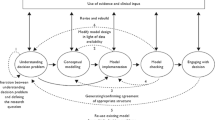Abstract
When a model is built, it tends to be an iterative process. The ideal model building process starts with constructing a top-level model (that works) and then digging deeper into the sections that need more details. A good model tends to have a long life and be both adapted and updated. A perfectly transparent first model (in whatever platform or programming language it might be) therefore tends to get increasingly convoluted. Yet, it still needs to be submitted and reviewed since it will likely be used as support to facilitate possibly multi-million Euro decisions. So, any modelling method should be able to accept substantial changes and updates of the model without compromising (any hopefully existing) transparency. One method that is gaining traction has its heritage in one of the oldest types of structured algorithms we have—the cooking recipe. Regardless of whether you are looking at a recipe for Swedish meatballs or a recipe to prepare the poisonous Fugu fish, the structure of the recipe is the same. It begins with a list of ingredients with the cooking steps to follow. Combining the ‘recipe’ idea with a common software like Excel® (which tends to be available on most computers), and the need to ‘cook’ all kinds of different model types (Markov, micro-simulation, discrete-event simulation, partitioned survival), leads to the DICE method (Caro in Pharmacoeconomics 34(7):655–672, 2016). It starts by listing the initial take on the ingredients needed for the model (in DICE called ‘conditions’). Just like writing a recipe, it is easy to add ingredients to this list later as needed. Then the actual ‘cooking’ is specified as a list of the events needed to fully represent the disease and interventions that will take place, followed by the instructions for each event. Using this approach, it becomes as easy to look at different models as it is to look at different recipes. The simplicity, flexibility and standardized structure, but especially its transparency, are the main features of DICE.






Similar content being viewed by others
References
Caro JJ. Discretely integrated condition event (DICE) simulation for pharmacoeconomics. Pharmacoeconomics. 2016;34(7):665–72.
Eddy D, Hollingworth W, Caro JJ, Tsevat J, McDonald KM, Wong JB. Model transparency and validation: a report of the ISPOR-SMDM modeling good research practices task force-7. Value Health. 2012;15:843–50.
Incerti D, Thom H, Baio G, Jansen JP. R you still using excel? The advantages of modern software tools for health technology assessment. Value Health. 2019;22(5):575–9.
Davis S, Stevenson M, Tappenden P, Wailoo A. “NICE DSU technical support document 15: cost-effectiveness modelling using patient-level simulation. Report By the Decision Support Unit,” London, 2014.
Merlin T, Tamblyn D, Schubert C. Guidelines for preparing a submission to the Pharmaceutical Benefits Advisory Committee, Version 5.0. Australian Government, Department of health, 2016.
Caro JJ. Psst, have i got a model for you. Med Decis Mak. 2015;35(2):139–41.
Ghabri S, Stevenson M, Moller J, Caro JJ. Trusting the results of model based economic analyses: is there a pragmatic validation solution? Pharmacoeconomics. 2019;37(1):1–6.
Naltrexone–bupropion for managing overweight and obesity. Technology appraisal guidance [TA494], 12 Dec 2017 [Online]. https://www.nice.org.uk/guidance/ta494/. Accessed 7 Jul 2019.
Author information
Authors and Affiliations
Corresponding author
Ethics declarations
Funding
The preparation of this article was not funded, but the author is an employee of Evidera.
Conflict of interest
JM has no financial conflict of interest, but an intellectual conflict in the sense that he has coded the current engine running the open-source version of the DICE engine.
Ethical approvals and informed consent
For this type of study, formal consent is not required, nor is any informed consent process. This article does not contain information from any studies with human participants or animals.
Rights and permissions
About this article
Cite this article
Möller, J. Cooking Up a Transparent Model Following a DICE Recipe. PharmacoEconomics 37, 1341–1347 (2019). https://doi.org/10.1007/s40273-019-00840-2
Published:
Issue Date:
DOI: https://doi.org/10.1007/s40273-019-00840-2




